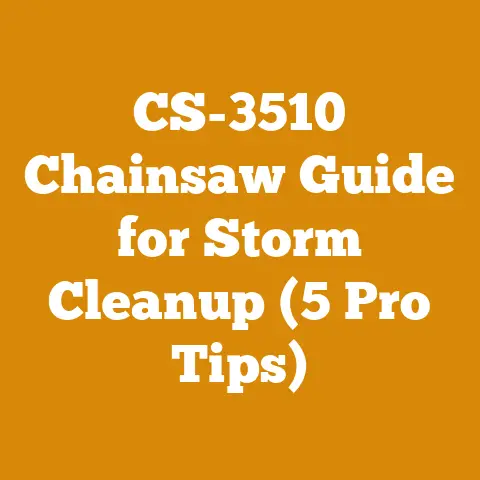Chainsaw Ear Protection (5 Pro Tips for Arborists)
Let’s dive in.
The Arborist’s Ears: Why Chainsaw Ear Protection is Non-Negotiable
Before we even touch a chainsaw, let’s talk safety. In my years around logging sites and wood processing yards, I’ve seen too many preventable accidents. Chainsaws are powerful tools, vital for arborists, loggers, and anyone preparing firewood, but they are inherently dangerous. One of the most overlooked aspects of safety is hearing protection. I’m not just talking about comfort; I’m talking about preserving your ability to hear for years to come. The user intent of “Chainsaw Ear Protection (5 Pro Tips for Arborists)” is clear: to understand why hearing protection is crucial when using chainsaws and to learn practical tips for selecting and using the right ear protection.
Noise-induced hearing loss (NIHL) is insidious. It creeps up on you. You might not notice it at first, but years of exposure to loud noises, like the roar of a chainsaw, can lead to irreversible damage. Tinnitus (ringing in the ears) is another common consequence, and trust me, it’s not something you want to live with.
I remember one old-timer, Earl, who worked at the sawmill. He scoffed at ear protection. “Never needed it before,” he’d say, cupping his hand to his ear. By the time he retired, he was practically deaf. He couldn’t hear his grandkids, couldn’t enjoy music, and struggled to communicate. That image stuck with me, and it’s why I’m so passionate about promoting proper hearing protection.
The purpose of this guide is to equip you with the knowledge and practical tips you need to protect your hearing when using a chainsaw. We’ll cover everything from understanding noise levels to choosing the right ear protection and implementing best practices. This isn’t just about following regulations; it’s about taking responsibility for your long-term health and well-being.
What is Noise-Induced Hearing Loss (NIHL)?
NIHL is hearing impairment resulting from exposure to high decibel (dB) levels of sound. The tiny hair cells in your inner ear vibrate when sound waves enter. Prolonged or repeated exposure to loud noise damages these cells, leading to hearing loss. Once damaged, these cells don’t regenerate.
The louder the noise and the longer the exposure, the greater the risk of NIHL. Chainsaws, operating at around 100-115 dB, pose a significant threat. Even short-term exposure without protection can cause temporary hearing loss or tinnitus. Over time, this temporary damage can become permanent.
Understanding Decibel Levels and Chainsaw Noise
Let’s put chainsaw noise into perspective. Here’s a quick rundown of common decibel levels:
- Whisper: 30 dB
- Normal Conversation: 60 dB
- Lawnmower: 90 dB
- Chainsaw: 100-115 dB
- Rock Concert: 110-120 dB
- Jet Engine at Takeoff: 140 dB
The Occupational Safety and Health Administration (OSHA) sets permissible exposure limits (PELs) for noise in the workplace. OSHA’s PEL for noise is 90 dBA for an 8-hour time-weighted average (TWA). However, the National Institute for Occupational Safety and Health (NIOSH) recommends a more conservative exposure limit of 85 dBA for an 8-hour TWA.
Even brief exposure to chainsaw noise above these limits can be damaging. For example, at 110 dB, damage can occur in as little as 30 minutes. This highlights the importance of consistent ear protection, even for short tasks.
5 Pro Tips for Arborists: Chainsaw Ear Protection
Now, let’s get to the heart of the matter: practical tips for protecting your hearing when using a chainsaw.
Tip 1: Choose the Right Ear Protection
Selecting the right ear protection is paramount. Not all earplugs and earmuffs are created equal. The key metric to look for is the Noise Reduction Rating (NRR). The NRR indicates how much the ear protection reduces noise levels. For example, an NRR of 30 dB means the ear protection reduces noise by 30 dB under ideal laboratory conditions.
Earplugs:
- Foam Earplugs: These are inexpensive and readily available. They typically have an NRR of 29-33 dB. Roll them between your fingers to compress them, insert them deeply into the ear canal, and hold them in place until they expand. The fit is crucial; a poor fit significantly reduces their effectiveness. I usually buy them in bulk.
- Molded Earplugs: These are reusable and often custom-fitted. They offer a more comfortable and consistent fit than foam earplugs. Their NRR varies, so check the specifications. I have a pair of custom-molded earplugs made by an audiologist, and they are worth the investment for all-day comfort and reliable protection.
- Flanged Earplugs: Made from silicone or plastic, these earplugs feature multiple flanges that create a seal in the ear canal. They are reusable and easy to clean.
Earmuffs:
- Over-the-Head Earmuffs: These provide a consistent level of protection and are easy to put on and take off. Look for earmuffs with a high NRR rating. Some models also feature electronic noise cancellation or communication capabilities.
- Behind-the-Head Earmuffs: These are ideal for wearing with hard hats or other headgear. They offer the same level of protection as over-the-head earmuffs but are more versatile in terms of compatibility.
- Hard Hat-Mounted Earmuffs: These attach directly to a hard hat, providing convenient and reliable hearing protection. They are especially useful for arborists and loggers who are required to wear hard hats.
How to Choose:
When choosing ear protection, consider the following factors:
- NRR: Select ear protection with an NRR that is appropriate for the noise levels you will be exposed to. A general rule of thumb is to subtract 7 from the NRR and then subtract that number from the noise level to estimate the actual noise exposure. For example, if you’re using a chainsaw that produces 110 dB and you’re wearing earplugs with an NRR of 30 dB, your estimated noise exposure is 110 – (30-7) = 87 dB.
- Comfort: Choose ear protection that is comfortable to wear for extended periods. Ill-fitting ear protection can be irritating and may not provide adequate protection.
- Compatibility: Ensure that the ear protection is compatible with other personal protective equipment (PPE), such as hard hats, safety glasses, and face shields.
- Environment: Consider the environment in which you will be working. In hot and humid conditions, earmuffs can become uncomfortable. In dusty or dirty environments, earplugs may be more practical.
- Personal Preference: Ultimately, the best ear protection is the one that you will consistently wear. Experiment with different types of ear protection to find what works best for you.
My Experience:
I personally prefer earmuffs for most chainsaw work. They’re easy to put on and take off, and I find them more comfortable than earplugs, especially in cold weather. However, I always keep a pair of foam earplugs in my pocket as a backup. I also use hard hat-mounted earmuffs when working at height.
Tip 2: Ensure a Proper Fit
Even the best ear protection is ineffective if it doesn’t fit properly. A poor fit can significantly reduce the NRR.
Earplugs:
- Foam Earplugs: Roll the earplug tightly between your fingers to compress it. Reach over your head with the opposite hand and pull up and back on your ear to straighten the ear canal. Insert the earplug deeply into the ear canal and hold it in place until it expands. The earplug should fit snugly and block out most of the noise.
- Molded Earplugs: Follow the manufacturer’s instructions for inserting and removing molded earplugs. Ensure that the earplugs fit snugly and create a tight seal in the ear canal.
- Flanged Earplugs: Insert the earplug into the ear canal, twisting it slightly to ensure a good seal. The flanges should fit snugly against the ear canal walls.
Earmuffs:
- Positioning: Position the earmuffs so that the earcups completely cover your ears. The headband should fit snugly but not too tightly.
- Hair: Make sure that your hair does not interfere with the seal between the earcups and your head. Long hair should be pulled back or tucked behind your ears.
- Adjustments: Adjust the headband and earcups as needed to ensure a comfortable and secure fit.
Fit Testing:
Fit testing is a process that verifies the effectiveness of ear protection. It involves measuring the amount of noise reduction provided by the ear protection in a real-world setting. Fit testing can be performed by a qualified audiologist or occupational health professional. I recommend getting a fit test done, especially if you’re using earplugs, to ensure that you’re getting the protection you need.
My Experience:
I once had a fit test done with my foam earplugs, and I was surprised to learn that I wasn’t inserting them properly. I thought I was getting a good seal, but the fit test revealed that I was only achieving about half the NRR. The audiologist showed me the correct technique, and it made a huge difference.
Tip 3: Wear Ear Protection Consistently
This might seem obvious, but it’s crucial. Ear protection is only effective if you wear it consistently whenever you’re exposed to chainsaw noise. Even brief periods of unprotected exposure can contribute to NIHL.
Develop a Habit:
Make it a habit to put on your ear protection before you start any task that involves a chainsaw. Keep your ear protection readily accessible, such as in your toolbox, on your hard hat, or in your pocket.
Communicate with Others:
If you’re working with a team, remind each other to wear ear protection. Peer pressure can be a powerful tool for promoting safety.
Lead by Example:
As a supervisor or team leader, set a good example by always wearing ear protection yourself. Your actions will speak louder than words.
My Experience:
I once worked on a logging crew where the foreman was lax about ear protection. He’d often take his earmuffs off to talk to people, even when the chainsaws were running. It wasn’t long before several members of the crew started experiencing hearing problems. That experience taught me the importance of consistent ear protection and the need for strong leadership in promoting safety.
Tip 4: Maintain and Inspect Your Ear Protection
Like any piece of safety equipment, ear protection needs to be properly maintained and inspected regularly.
Earplugs:
- Foam Earplugs: Dispose of foam earplugs after each use. They are not designed to be reused.
- Molded Earplugs: Clean molded earplugs regularly with mild soap and water. Allow them to air dry completely before storing them. Inspect them for cracks, tears, or other damage. Replace them if they are damaged.
- Flanged Earplugs: Clean flanged earplugs regularly with mild soap and water. Inspect them for damage and replace them if necessary.
Earmuffs:
- Cleaning: Clean earmuffs regularly with a damp cloth. Avoid using harsh chemicals or solvents, which can damage the earcups and headband.
- Inspection: Inspect the earcups and headband for cracks, tears, or other damage. Replace the earcups if they are worn or damaged. Check the tension of the headband and adjust it as needed.
- Storage: Store earmuffs in a clean, dry place when not in use. Avoid exposing them to extreme temperatures or direct sunlight, which can damage the materials.
My Experience:
I’ve learned the hard way that neglecting ear protection maintenance can lead to problems. I once had a pair of earmuffs that I didn’t clean regularly. Over time, the earcups became stiff and cracked, and the headband lost its tension. The earmuffs no longer provided adequate protection, and I had to replace them.
Tip 5: Consider Electronic Ear Protection
Electronic ear protection offers several advantages over traditional earplugs and earmuffs.
Noise Cancellation:
Some electronic earmuffs feature active noise cancellation (ANC) technology. ANC uses microphones to detect ambient noise and then generates an opposing sound wave to cancel out the noise. This can significantly reduce noise levels, especially low-frequency noise.
Communication:
Many electronic earmuffs also feature built-in communication systems. These systems allow you to communicate with other members of your team without removing your ear protection. This is especially useful in noisy environments where it can be difficult to hear.
Situational Awareness:
Some electronic earmuffs amplify ambient sounds, allowing you to hear important sounds, such as warning signals or approaching vehicles. This can improve situational awareness and safety.
Cost:
Electronic ear protection is typically more expensive than traditional earplugs and earmuffs. However, the added benefits may be worth the investment, especially for arborists and loggers who work in noisy environments for extended periods.
My Experience:
I’ve been using electronic earmuffs with noise cancellation and communication capabilities for several years, and I wouldn’t go back to traditional earmuffs. The noise cancellation is incredibly effective, and the communication system makes it much easier to work with my team. I can hear what’s going on around me without being exposed to excessive noise.
Beyond the Tips: Additional Considerations
While the five pro tips above are essential, there are a few additional considerations to keep in mind.
Noise Surveys and Monitoring
Employers have a responsibility to conduct noise surveys and monitoring to assess the noise levels in the workplace. This information can be used to determine the appropriate type of ear protection and to implement other noise control measures.
Noise surveys involve measuring the noise levels in different areas of the workplace using a sound level meter. The results of the noise survey are used to create a noise map, which identifies areas where noise levels exceed the OSHA PEL or the NIOSH recommended exposure limit.
Noise monitoring involves measuring the noise exposure of individual employees over a period of time. This can be done using a personal noise dosimeter, which is a small device that is worn by the employee and records their noise exposure throughout the workday.
Engineering Controls
Engineering controls are measures that are taken to reduce noise levels at the source. Examples of engineering controls include:
- Using quieter equipment: Choose chainsaws and other equipment that produce less noise.
- Maintaining equipment: Keep equipment in good repair to minimize noise.
- Isolating noise sources: Enclose noisy equipment or locate it away from workers.
- Using sound-absorbing materials: Install sound-absorbing materials on walls and ceilings to reduce reverberation and noise levels.
Administrative Controls
Administrative controls are measures that are taken to reduce noise exposure by changing work practices. Examples of administrative controls include:
- Limiting exposure time: Reduce the amount of time that workers are exposed to noise.
- Providing rest breaks: Allow workers to take rest breaks in quiet areas.
- Rotating workers: Rotate workers between noisy and quiet tasks.
- Training: Provide workers with training on the hazards of noise and how to protect their hearing.
Hearing Conservation Programs
OSHA requires employers to implement a hearing conservation program if workers are exposed to noise levels at or above 85 dBA for an 8-hour TWA. A hearing conservation program includes the following elements:
- Noise monitoring: As described above.
- Hearing protection: Providing workers with appropriate ear protection and ensuring that it is used correctly.
- Audiometric testing: Conducting regular hearing tests to monitor workers’ hearing and detect any changes.
- Training: Providing workers with training on the hazards of noise and how to protect their hearing.
- Recordkeeping: Maintaining records of noise monitoring, audiometric testing, and training.
Chainsaw Selection and Maintenance for Noise Reduction
While ear protection is paramount, choosing the right chainsaw and maintaining it properly can also contribute to reducing noise exposure.
Chainsaw Selection
- Electric Chainsaws: Electric chainsaws are generally quieter than gasoline-powered chainsaws. While they may not be as powerful, they are suitable for many tasks, especially smaller jobs around the yard. I’ve found them to be surprisingly capable for limbing and cutting smaller firewood rounds.
- Low-Noise Models: Some chainsaw manufacturers offer models that are specifically designed to be quieter. These models often feature noise-dampening technology and optimized engine designs.
- Engine Size: Choose a chainsaw with an engine size that is appropriate for the tasks you will be performing. A larger engine will generally produce more noise.
Chainsaw Maintenance
- Sharpening the Chain: A dull chain requires more effort to cut, which can lead to increased engine speed and noise. Keep your chain sharp to reduce noise and improve cutting efficiency. I use a file guide to ensure consistent sharpening angles.
- Cleaning the Air Filter: A dirty air filter can restrict airflow to the engine, causing it to run harder and produce more noise. Clean the air filter regularly according to the manufacturer’s instructions.
- Lubricating the Chain: Proper chain lubrication reduces friction and helps the chain cut smoothly. This can also reduce noise.
- Checking the Muffler: The muffler is designed to reduce engine noise. Inspect the muffler regularly for damage and replace it if necessary.
Case Study: Implementing a Hearing Conservation Program at a Small Logging Business
Let’s look at a real-world example of how a small logging business implemented a hearing conservation program.
The Challenge:
A small logging business with five employees was experiencing increasing concerns about noise exposure. Several employees had reported tinnitus and difficulty hearing. The business owner recognized the need to implement a hearing conservation program to protect the employees’ hearing.
The Solution:
The business owner took the following steps:
- Noise Survey: Hired a qualified consultant to conduct a noise survey of the logging site. The survey revealed that noise levels consistently exceeded 85 dBA in several areas.
- Hearing Protection: Provided employees with a choice of high-NRR earmuffs and earplugs. Ensured that employees were properly fitted with the ear protection and trained on how to use it correctly.
- Audiometric Testing: Arranged for annual audiometric testing for all employees. The testing was conducted by a certified audiologist.
- Training: Provided employees with annual training on the hazards of noise, the importance of hearing protection, and the proper use of ear protection.
- Engineering Controls: Implemented several engineering controls to reduce noise levels, including:
- Replacing older, noisier chainsaws with newer, quieter models.
- Enclosing the chainsaw sharpening area to reduce noise exposure.
- Using sound-absorbing materials in the break room.
- Administrative Controls: Implemented several administrative controls to reduce noise exposure, including:
- Limiting the amount of time that employees spent in noisy areas.
- Providing employees with rest breaks in quiet areas.
- Rotating employees between noisy and quiet tasks.
The Results:
The implementation of the hearing conservation program resulted in the following:
- Reduced noise exposure for employees.
- Improved employee morale and productivity.
- Reduced the risk of NIHL.
- Compliance with OSHA regulations.
Key Takeaways:
This case study demonstrates that even a small business can successfully implement a hearing conservation program. The key is to take a proactive approach, involve employees in the process, and implement a combination of engineering controls, administrative controls, and hearing protection.
Strategic Insights: Long-Term Hearing Health
Protecting your hearing is not just about complying with regulations; it’s about investing in your long-term health and well-being. NIHL is irreversible, and it can have a significant impact on your quality of life.
Beyond the Workplace:
Be mindful of noise exposure in your personal life as well. Loud music, power tools, and recreational activities can all contribute to NIHL. Wear ear protection when you’re exposed to loud noise, even if it’s just for a short period of time.
Regular Hearing Checkups:
Get regular hearing checkups, especially if you work in a noisy environment. Early detection of hearing loss can help you take steps to prevent further damage.
Advocate for Hearing Health:
Speak out about the importance of hearing protection. Encourage your colleagues, friends, and family to take steps to protect their hearing.
- Assess Your Noise Exposure: Evaluate the noise levels in your work environment and identify areas where noise levels exceed 85 dBA.
- Choose the Right Ear Protection: Select ear protection that is appropriate for the noise levels you will be exposed to. Consider factors such as NRR, comfort, compatibility, and personal preference.
- Ensure a Proper Fit: Make sure that your ear protection fits properly. If you’re using earplugs, learn the correct insertion technique. If you’re using earmuffs, adjust the headband and earcups for a comfortable and secure fit.
- Wear Ear Protection Consistently: Develop a habit of wearing ear protection whenever you’re exposed to chainsaw noise.
- Maintain and Inspect Your Ear Protection: Clean and inspect your ear protection regularly. Replace worn or damaged ear protection.
- Consider Electronic Ear Protection: Explore the benefits of electronic ear protection, such as noise cancellation, communication, and situational awareness.
- Implement Engineering and Administrative Controls: Take steps to reduce noise levels at the source and to minimize noise exposure through work practices.
- Get Regular Hearing Checkups: Schedule regular hearing checkups to monitor your hearing and detect any changes.
- Educate Others: Share your knowledge with your colleagues, friends, and family. Encourage them to take steps to protect their hearing.
Conclusion: Protecting Your Hearing, Preserving Your Future
Chainsaws are indispensable tools, but they come with inherent risks, including the risk of noise-induced hearing loss. By following the pro tips outlined in this guide, you can significantly reduce your risk of NIHL and preserve your ability to hear for years to come. Remember, hearing protection is not just a requirement; it’s an investment in your long-term health and well-being. Don’t take your hearing for granted. Protect it. As I’ve learned over the years, your ears are your livelihood, and they deserve the best protection you can give them.






